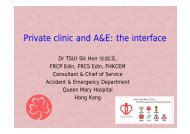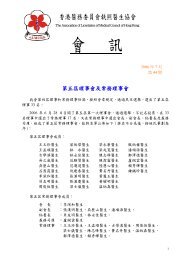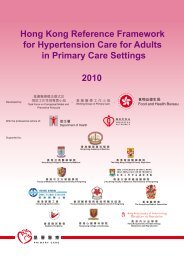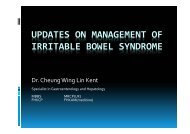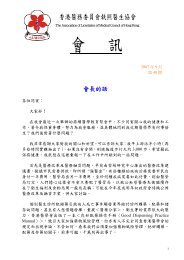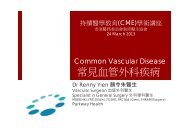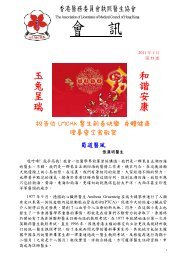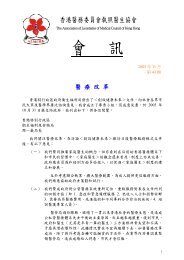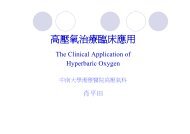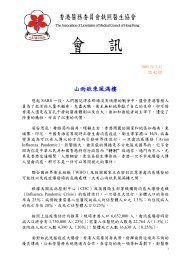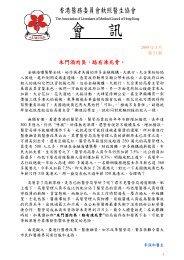Coronary artery disease
Coronary artery disease
Coronary artery disease
- No tags were found...
You also want an ePaper? Increase the reach of your titles
YUMPU automatically turns print PDFs into web optimized ePapers that Google loves.
Cardiac complaints Chest / epigastric pain Shortness of breath Palpitations Dizziness & headache Syncope
Management of ACSST-elevation MIPrimary PCI (aim for “Door-to-Balloon” time
Diagnosis & treatment ofcoronary <strong>artery</strong> <strong>disease</strong>
Diagnosis ofcoronary <strong>artery</strong> <strong>disease</strong>
Diagnosis ofcoronary <strong>artery</strong> <strong>disease</strong>
Functional assessment ofcoronary <strong>artery</strong> <strong>disease</strong>Exercise thallium(Nuclear Medicine)Stress PerfusionMagnetic resonance Imaging
Treatment ofcoronary <strong>artery</strong> <strong>disease</strong>Antiplatelet therapy (monitor using PFA-100, Verify Now) Aspirin (100-300mg q.d.) Clopidogrel (75mg q.d.) – Plavix resistance inCYP2C19*2 and *3 alleles – no functional metabolism ofPlavix Prasugrel (10mg q.d.) – reduce to 5mg q.d. for pt > 75yearsStatinsAtorvastatin (Lipitor)Rosuvastatin (Crestor)
Treatment ofcoronary <strong>artery</strong> <strong>disease</strong>Beta-blockers Avoid in patients with asthma, prostatic hypertrophy,brittle DMIvabradine (Coralan) Selective sinus node I f inhibitor For patients with HR > 70/min – anti-anginal & antiischaemiceffectsCalcium channel blockers Amlodipine Diltiazem Nifedipine (reflex tachycardia)
Treatment ofcoronary <strong>artery</strong> <strong>disease</strong>Nitrates TNG SL PRN Long-acting isosorbide mononitrate (to avoid tolerance) Nitrate patchTrimetazidine (Vastarel) Metabolic agent (3-KAT inhibitor) which acts on fattyacid β-oxidationIncreases glucose oxidation and ATP productionOptimizes cardiac metabolism under ischaemicconditions
Evaluation and Treatment of PatientsPresenting With Acute DyspneaPatient presenting with dyspneaPhysical examination, chest x-ray,ECG, BNP levelBNP 500 pg/mLDecompensatedHF very probable (95%)Treatment Options(noncardiac)Pulmonary <strong>disease</strong>-bronchodilators-oxygen-etcAnemia RxOtherNo“Grey Zone” BNP ConsiderPECardiac Ischemia (ACS)SepsisRenal FailureCor PulmonaleYes, HF likely (90%)Admit: Treat for HFDiuretics, inotropes,vasodilators√BNP level before DCTreatment Options:Diuretics as required; adjust oral medsConsider DC to homeAdapted from Maisel A. Rev Cardiovasc Med. 2002;3(suppl 4):S10–S17.Mueller C et al. N Engl J Med. 2004;350:647-54.
Acute heart failure
Heart Failure DiagnosticAlgorithmPatient with dyspnea orother HF signs/symptomsHistory/physicalexam/ECG/chest x-rayNondiagnostic1stBNP blood testDrives Decision1stNegative (< 100 pg/ml)Evaluate for non-HF etiologies(echocardiography usually not indicated)Adapted from McCullough PA, Minerva Cardioangiol. 2005Diagnostic for CHFBNP blood test with Admit LabsPositive (> 500 pg/ml)“Grey Zone” (100- 500 pg/ml)•HF•PE2nd•Ischemia•Sepsis•Renal Failure•Cor PulmonaleAcute HFmanagement(echocardiography, ifnot done previously)BNP blood testBefore D/C
Critical Cutpoints for BNPHeuristic or “Rule of Thumb”‣ BNP < 50 pg/ml effectively rules out CHF‣ BNP ~250 pg/ml compensated CHF• Diastolic heart failure• Systolic heart failure‣ BNP > 500 pg/ml decompensated CHF‣ BNP > 1000 pg/ml can only be due to CHFFDA Cutoff 100 pg/mlMaisel AS, McCullough PA. Cardiac Natriuretic Peptides: A Proteomic Window to Cardiac Function and ClinicalManagement. Rev Cardiovasc Med 2003, Suppl4 (4): S3-S12.
Pharmacological treatmentof CHFNYHA FC I II III IVACEI + + + +Beta-blockers + + + +ARB + + +Hydrallazine+ + ++ ISDNDiuretics + + +Digoxin + + +Inotropes +
Diuretics Recommended to restore and maintain normal volumestatus in patients with clinical evidence of fluidoverload, generally manifested by:– Congestive symptoms– Signs of elevated filling pressures Loop diuretics (e.g. frusemide, bumetanide, torasemide)rather than thiazide-type diuretics are typicallynecessary to restore normal volume status in patientwith HF Once diuretic effect is achieved, increase frequency to 2-3 times a day if necessary, rather than increasing asingle dose Oral torasemide may be considered in patientsexhibiting poor absorption of oral medications orerratic diuretic effect
ACEIe.g.enalapril (CONSENSUS, SOLVD)captopril (SAVE)ramipril (HOPE)Major side-effects: hypotension renal dysfunction (esp those with pre-existingrenal dysfunction or those with evidence ofexcessive neurohormonal activation such ashyponatraemia) dry cough
ACEIstrength of evidenceRecommended for symptomatic andasymptomatic patients with LVEF < 40% AShould be titrated to doses used in clinical trials(as tolerated during uptitration of othermedications such as beta-blockers)CRecommended as routine therapy forasymptomatic patients with an LVEF < 40%⎯Post MIB⎯Non-post MIC
Substitutes for ACEIIn patients who cannot tolerate ACEI due tocough, ARBs are recommendedAThe combination of hydrallazine and an oralnitrate may be considered in such patients nottolerating ARBsCPatients intolerant to ACEI due tohyperkalaemia or renal insufficiency are likely toexperience the same side effects with ARBs C
ACEI Start at low dose and titrate to higher doses astolerated ACEI with longer half-life (e.g. lisinopril,ramipril) may be less likely to cause dizziness andhypotension Monitor renal function and serum potassium If renal dysfunction, consider changing tofosinopril (dual renal & hepatic excretion) & ruleout renal <strong>artery</strong> stenosis
ACEI-related cough cough may be related to pulmonary venouscongestionATLAS – patients taking high dose of lisinoprilhad a lower incidence of cough try to increase the dose of ACEI and diureticsfirst if no improvement, change to ARB
How to use beta-blockers inCHF? Clinically stable patients in all classes of HF Recommended for patients with recentdecompensation of HF after optimization ofvolume status and successful discontinuation of IVdiuretics and vasoactive drugs start with low dose and slow dose up-titrationaccording to tolerance, e.g.starting dose target doseMetoprolol(CR) 12.5-25 mg q.d. 200 mg q.d.Carvedilol 3.125 mg b.d. 6.25-25 mg b.d.Bisoprolol 1.25 mg q.d. 10 mg q.d.
Beta-blockers Recommended for symptomatic and asymptomaticpatients with LVEF < 40%A Recommended as routine therapy forasymptomatic patients with LVEF < 40%– Post-MI B– Non-post MI C
Beta-blockers & Concomitant<strong>disease</strong> BB is recommended in the great majority of patientswith LV systolic dysfunction – even if there isconcomitant diabetes, chronic obstructive lung<strong>disease</strong> or peripheral vascular <strong>disease</strong> Use with caution in patients with– DM with recurrent hypoglycaemia– Asthma or resting limb ischaemia Use with considerable caution in patients withmarked bradycardia (< 55bpm) or markedhypotension (SBP < 80mmHg) not recommended in patients with asthma withactive bronchospasm
Beta-blockers – in PreservedLVEF & the elderly BB is recommended in patients with HF andpreserved LVEF who have:– Prior MI– Hypertension– Atrial fibrillation requiring control of ventricularrate BB and ACEI is recommended as standard therapyin all elderly patients with HF due to LV systolicdysfunction In the absence of contraindications, these therapiesare also recommended in the very elderly (age > 80years)
Initial therapy –Beta-blockers or ACEI? CIBIS III 1010 chronic stable HF patients (NYHA II-III, LVEF
Angiotensin ReceptorBlockers (ARB) Angiotensin II Type 1 (AT1) Blockerse.g. LosartanValsartanCandesartanIrbesartan Recommended for routine administration tosymptomatic and asymptomatic patients with anLVEF < 40% who are intolerant to ACEI forreasons other than hyperkalaemia or renalinsufficiency
ARBARBS in Patients Not Taking ACE Inhibitors:Val-HeFT & CHARM-Alternative100Val-HeFT50CHARM-AlternativeSurvival %90807060ValsartanPlaceboCV Death or HF Hosp %40302010PlaceboCandesartan50p = 0.0170 3 6 9 12 15 18 21 24 270HR 0.77, p = 0.00040 9 18 27 36 42MonthsMonthsMaggioni AP et al. JACC 2002;40:1422-4.Granger CB et al. Lancet 2003;362:772-6.
ARB + ACEI in CHF? Benefit not seen across the entire class of ARB Valsartan – trend towards increased risk of deathor hospitalization Candasartan – improved the outcome of patientswith heart failure when combined with ACEI andBeta-blockers⇒For HF patients who remain symptomaticdespite ACEI and BB therapy, candesartan maybe added
Hydrallazine + oralnitrate Can be given as alternative to ACEI for patientswho are unable to tolerate ACEI due to renalfailure or hyperkalaemia Can be recommended as part of standard therapy,in addition to BB and ACEI, for AfricanAmericans with LV dysfunction (class II-IV)
Aldosterone antagoniste.g. spironolactone (RALES), eplerenone (EPHESUS) Recommended for patients on standard therapy,including diuretics, who have:– NYHA class IV HF (or class III, previously classIV) due to LV systolic dysfunction (LVEF
Aldosterone antagonistAldosterone Antagonists in HFRALES (Advanced HF)EPHESUS (Post-MI)1.001.00Probability of Survival0.900.800.700.600.50RR = 0.70P < 0.001PlaceboSpironolactone0.900.800.700.600.50RR = 0.85P < 0.008PlaceboEpleronone0.400 3 6 9 12 15 18 21 24 27 30 33 360.400 3 6 9 12 15 18 21 24 27 30 33 36MonthsMonthsPitt B. N Engl J Med 1999;341:709-17.Pitt B. N Engl J Med 2003;348:1309-21.
Aldosterone antagonist Not recommended when– Creatinine > 2.5mg/dl (or clearance < 30ml/min)– Serum potassium > 5.0 mmol/l– Therapy includes other potassium-sparingdiuretics Measure potassium at baseline, then 1 week, 1month and every 3 months Supplemental potassium is not recommendedunless potassium is < 4.0mmol/l
DigoxinUseful in treating heart failure patients with AF (positiveinotropy, negative chronotropy and digoxin’s ability tofavourably modulate neurohormonal factors in CHF)? for patients in SR Addition of digoxin to background therapy of ACEIand diuretic therapy reduces hospitalization due toworsening heart failure (neutral effect on mortality) Withdrawal of digoxin in stable heart failure patients isassocaited with higher adverse event ratesDigoxin toxicity: N&V, arrhythmias
When to admit patient with CHF?Acute decompensation of heart failureComplications of heart failure e.g. atrialfibrillation, ventricular arrhythmias,thrombus formationNeed for other advanced therapies such asimplantation of device therapy, mechanicalcirculatory support, work-up for hearttransplant
Treatment goals for hospitalizedpatients Improve symptoms, especially congestion and lowoutputsymptoms Optimize volume status Identify aetiology Identify precipitating factors Optimize chronic oral therapy; minimize sideeffects Identify who might benefit from revascularization Educate patients concerning medication and HFself-assessment Consider enrolment in a specialized centre
Device therapy for CHF – Cardiacresynchronization therapy (CRT)Venogram image prior toLV lead implantX-ray - LV lead in midlateralvein withbiventricular pacemaker
CRT – P (pacemaker)Baseline CXR8 months afterBiventricular pacing
CRT – D (Defibrillator )Defibrillation
Hypertensive Urgency &EmergencyHypertensive emergency (crisis) = severe elevation inBP (>180/120mmHg) complicated by evidence ofimpending or progressive target organ dysfunction, e.g.coronary ischaemia, disordered cerebral function,cerebrovascular events, pulmonary oedema, renalfailureHypertensive urgency = severe elevation in BP withoutprogressive target organ damage
Hypertensive Urgency &EmergencyDistinguish between hypertensive emergency versushypertensive urgency?chest pain (⇒ myocardial ischaemia / infarction)?SOB (⇒APO secondary to LVF)?back pain (⇒aortic dissection – significantdiscrepancy between arms >20mmHg)?neurological symptoms such as headache & blurryvision (⇒intracerebral or subarachnoid haemorrhageor hypertensive encephaopathy)
Management ofHypertensive UrgencyGoal – to reduce BP to 160/110 over several hoursCaptopril (25mg) – onset of action 15-30min; max dropin BP between 30 & 90min (avoid in hyperkalamia,renal failure)Labetalol (200mg) – onset of action 1-2 hoursNifedipine (5-10mg) – onset of action 10-20 minutes
Management ofHypertensive EmergencyType of emergencyHypertensiveencephalopathyAortic dissectionPulmonary oedemaCardiac ischaemiaPhaeochromocytomaEclampsiaDrug of choiceNitroprussideβ-blocker &nitroprussideNitroglycerinNitroglycerin +/- β-blockerNitroprusside + β-blockerMethyldopaMagnesium sulfate (nonot use with CBB)2nd-line drugLabetalolLabetalolNitroprussideNitroprusside,labetalolPhentolaminehydralazine
Syncope / dizzinessComplete Heart blockTrifascicular blockRBBB, left anteriorhemiblock (QRS axis >-30, R-wave in inf leads,absence of other cause ofleft axis deviation), longPR interval
Cardiac arrhythmiasHistory ?preceded by postural change ⇒ orthostatichypotension ?preceded by micturition ⇒ micturition syncope ?related to emotional upset ⇒ vasovagal ?exercise-induced ⇒ aortic stenosis, SVT, prolongedQT syndrome Look for high risk features e.g. cardiovascular <strong>disease</strong>,heart failure, history of ventricular arrhythmia
Investigation of syncope/dizziness24-hour HolterEvent MonitorImplantable loop recorder (ILR)Small device (6 x 2 x 0.8 cm)Implanted on the front of the chest under LATilt-table testFor diagnosis of neurocardiogenic syncope
Cardiac arrhythmiasInvestigations ECG – look for precursors to tachyarrhythmias:Delta wavesProlonged QT intervals (>500 msec)Short QT syndromes ( 120 msec) + axis deviationTrifascicular block = bifascicular block + first degree heart blockTroponin-I (suspected CAD)Ur/Cr, electrolytes (+/- Mg, Ca)Thyroid function test
Wolff-Parkinson-WhiteSyndrome
Cardiac arrhythmiasAdmit high-risk patients Syncope and CVD or heart failure Structural heart <strong>disease</strong> e.g. cardiomyopathy, HOCM Ventricular arrhythmias Abnormal ECG >65 years of age
AFHaemodynamic instability DC cardioversionStable patients Anticoagulant therapy & rate control Rhythm control with reversion (DC cardioversion oramiodarone) may be considered forFirst-time AFAged
Anticoagulation in AFLALVTrans-oesophageal echoCT scan
Anticoagulation in AFWarfarin Aim for INR between 2 and 3 Close monitoring of INR Multiple drug interactions
Anticoagulation in AFDabigatran (Pradaxa) Thrombin inhibitor RE-LY study - in prevention of stroke or systemicembolization in patients with AF: Dabigatran 110mg b.d. - non-inferior to warfarin(adjusted dose); less major bleeding Dabigatran 150mg b.d. – more effective than warfarin;similar bleedingConnolly S et al. Dabigatran versus warfarin in patients with AF.New Eng J Med 2009; 361(12): 1139-1151
Rhythm/rate controlClass 1 anti-arrhythmic drugs Propafenone Flecainide – avoid in patients with CADClass 2 anti-arrhythmic drugs Metoprolol, bisoprolol Propranolol – useful I thyrotoxic patients Sotalol – class 3 action; long QT interval
Rhythm/rate controlClass 3 anti-arrhythmic drugsAmiodarone Most effective anti-arrhythmic drugs for AF Different organ toxicities: Corneal microdeposits (>90%) Hyperthyroidism (0.9-2%) Hypothyroidism (6%) Liver function derangement (15-30%) Pulmonary toxicity (1-17%) Long half-life with drug accumulation in the body
Rhythm/rate controlDronedarone Synthetic benzofuran amiodarone derivative Better safety profile than amiodarone first anti-arrhythmic agent shown to reduce combinedoutcome of CV hospitalization or mortality in patientswith AF Can maintain SR with modest efficacy and controlventricular rate satisfactorily during episodes of AF No interaction with warfarin Side-effects: N&V, diarrhoea, dermatologic, reversibleincrease in creatinine level
Rhythm/rate controlDronedarone Should not be given with potent CYP3A4 inhibitorslike antifungals, macrolide antibiotics or proteaseinhibitors Lower doses of verapmail, diltiazem, digoxin,metoprolol should be used if given together withdronedarone Not suitable for patients with class III/IV (severe) heartfailure (ANDROMEDA) FDA approved for use in non-permanent AF or atrialflutter to reduce risk of CV hospitalization
Other treatments forarrhythmiasCatheter ablation (radiofrequency)Pacemakers (anti-tachycardic pacing, AF suppression)Implantable cardiovertor defibrillator (overdrivepacing, defibrillation)
D-dimer and VenousThromboembolismRecommendation 2: In appropriately selected patients with low pretest probabilityof DVT or pulmonary emobolism, obtaining a high-sensitivity D-dimer is areasonable option, and if negative indicates a low likelihood of VTE.
ECG in pulmonary embolism Look for changes suggestive of acute RV strain (RBBB,S1Q3T3, inverted precordial T-waves, or R axis shift) ECG often abnormal in PE but the findings areinsensitive and non-specific The most common findings are sinus tachycardiaand/or non-specific ST-T changes Anterior (V1-V4) T-wave inversions - consider massiveor sub-massive PE ECG is a poor diagnostic tool for PE. The greatestutility of ECG in patient with suspected PE is rulingout other potential life-threatening diagnoses such asMI
What is D-Dimer?Activation of CoagulationThrombinF XIII a- Increased D-Dimer level inblood indicates ongoingfibrinolysis to dissolveunwanted blood clot.- D-Dimer assay cut-offoptimized for high negativepredictive valueFibrinPlasminBy-product of Fibrin:D-DimerActivation of FibrinolysisCourtesy ofKent Lewandrowski MD, 2007
Strategy For Diagnosis ofPulmonary EmbolismClinical AssessmentOutpatientor EDInpatient orhigh riskD-dimerELISAImagingNormal: StopElevatedRenal insufficiencyor contrastallergy→V/Q ScanNondiagnostic scansFollowed up with leg USFor PENo renalinsufficiencyno contrast allergy,→Chest CT
Confirming Pulmonary EmbolismSpiral CT+ non-invasive+ high sensitivity- Time consuming- ExpensiveLung Scan (V-Q Scan)+ less invasive thanangiography- Time Consuming- Expensive- Result can be uncertainAngiography+ Clear diagnosis possible- Invasive- Expensive- Time consuming
Treatment Algorithm inConfirmed Pulmonary EmbolismKucher N, Goldhaber. Circulation 2003;108:2191-2194



